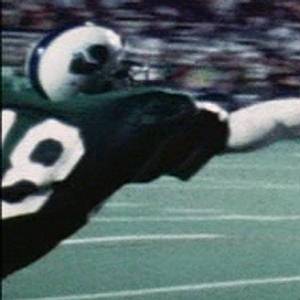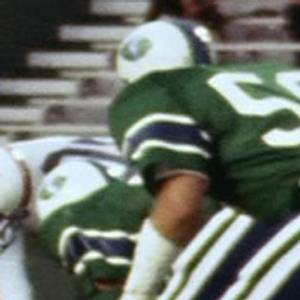

Portland
WFL
Thunder
- 1975
Greg Barton earned Junior College All America honors playing quarterback at
Long Beach City College with a team that had to be one of the strongest in the
nation. Teammates included future USC All Americans Ron Yary, Mike Battle, and
Earl McCullough. Barton played quarterback at Tulsa and was recognized as one of
the best passers in collegiate ball in 1966 and into 1967 until suffering a
separated shoulder that ended his season prematurely. Drafted by the Lions he
played behind Greg Landry and Bill Munson before playing out his option in 1970
when he went to Toronto of the CFL and filled a dual role of quarterback and
offensive coordinator. Sharing duties with Joe Thiesmann, Barton led the CFL
East Conference in passing and took the Argos to the Grey Cup. In 1972 he was
released as a player but retained as Director Of Player Personnel. In 1973 he
again had a dual role, this time as offensive coordinator and Assistant General
Manager. He played the entire season for the Portland Storm in 1974 and as the
team entered the 1975 season he worked tirelessly to keep the players together
as a unit and sought local investors for ownership. More than any other
individual Barton persevered to save the franchise. When attorney Richard
Bayless stepped in to assume ownership, he hired oft-traveled Bob Brodhead as
President and General Manager. Brodhead was recognized as one of the all time
greats of minor league football. Failing to stick with either the Buffalo Bills
of the AFL or Saskatchewan of the Canadian Football League, he played six
seasons in various minor leagues, earning a salary that was on par with what the
NFL was paying. General Manager of the Houston Oilers, Vice President and
Treasurer of the Cleveland Browns, Brodhead came to the newly named Portland
Thunder organization with the drive and background to oversee the operation in a
prudent and efficient manner. Brodhead’s first act was to name Greg Barton, all
of twenty-eight years of age as the youngest head football coach in the sport.
His second was to find a staff and players within the guidelines of the Hemmeter
Plan. Barton and Brodhead hired Ed
Dubaj who had done personnel work for both the Fire and Southmen in 1974, as the
Thunder’s offensive backs and receivers coach. They in effect rehired offensive
line coach Jim Martin, the former Browns and Lions star who had excelled at
seven different positions in the NFL after a storied All American career at
Notre Dame. Martin, a former Marine who had been awarded the Bronze Star For
Valor during World War II was highly respected by the players and his firm hand
was expected to provide a steadying influence on what was projected to be a
young team. Dale Lindsey came on as defensive coordinator after a nine-year
career at linebacker for the Cleveland Browns. He had spent 1974 as the Browns
linebacker coach. Storm defensive line coach Ray Braun was also retained. The
Thunder then began to fill out the roster with many players who had been with
the Portland team the year before, a result of Barton’s efforts at continuity in
the face of adversity and uncertainty. Bruce Bergey, older brother of Bengal and
Eagle linebacker Bill Bergey, was one of those who had labored with the Storm in
’74. A former UCLA standout at defensive end, Bergey had managed a year with the
Chiefs and two more with Toronto of the CFL before coming to the Storm. He had
the distinction of being the first player to sign with the new Thunder
franchise. A true tough guy, Bergey had won a Bronze Star For Heroism as a U.S.
Army Corporal in Viet Nam. Jerry Inman returned for another year in Portland
also. Inman was a local, attending high school in neighboring Vancouver,
Washington and then starting his collegiate career at Boise State before
transferring to and excelling at Oregon. He was a dependable defensive tackle
for the Denver Broncos from 1966 until being cut after the start of the 1974
season when he immediately joined the Storm for their final twelve games. Old
AFL veteran Dave Costa joined the Thunder some said, to be close to his friend
Inman. Costa had a rough and tumble reputation, having first played at Saunders
Trade And Technical High School in Yonkers, New York, a school that was a
caricature of an inner-city high school come-to-life in all of its hideous
aspects. Costa was suitably toughened by his time there. Believe it or not,
Northeastern Oklahoma Junior College had a hook in both Yonkers and the Bronx, a
pipeline formed by a former New York City area coach who had somehow wound up
out there. Costa took the bus to Northeastern and earned a scholarship to the
University Of Utah. The 6’2”, 250-pound defensive tackle was the seventh round
draft choice of the Oakland Raiders and played with them from 1963 through 1965.
One year with the Bills led to five with the Broncos, where he played next to
Inman until finishing his NFL career with the Chargers in 1972 and ’73. He made
a quick return trip to Buffalo in 1974 before signing on with the Thunder for
one more fling. He had teamed with Inman for five years and in that time had
appeared in four AFL All Star games.
On the offensive side,
adherence to the Hemmeter Plan almost guaranteed a return to 1974 form of not
having any really “big name” players. Leading Storm rusher Rufus “The
Roadrunner” Ferguson was back after a storied All Everything career at
Wisconsin, a year with Winnipeg and a brief 1973 stay in the Falcons camp.
Quarterback Don Horn, seen as a bust with four NFL teams earned the starting
spot with the Thunder and acquitted himself well, completing 158 passes in 272
attempts for 1742 yards and 11 touchdowns. With Ferguson adding 768 yards on the
ground, the Thunder had the foundation of a decent offense but the supporting
cast wasn’t strong enough so despite a respectable defense, they could muster no
more than a 4-7 record. Former USC football and track star Earl McCullouch was
one of the few track standouts that could also play football. After Bob Hayes
performed so well for the Dallas Cowboys, many track sprinters attempted to make
NFL rosters. John Carlos had been in camp with the NFL Eagles and in 1974, the
WFL New York Stars. Jim Hines and others from the 1968 U.S. Olympic team did not
come close to making it in the NFL. McCullouch was one of the rare ones, a true
football player who could also run track at a world record level. He was a
teammate of Barton’s at Long Beach City College after being one of the first to
set the tradition of football excellence at the now well-known Long Beach
Polytechnical High School. He was then a two-year starter on some of the best
teams ever produced at Southern Cal. He held the world record in the 120-yard
high hurdles from 1967 through 1972 and ran the leadoff leg of the USC 440 relay
team (with O.J. Simpson as a baton mate) that set the world record. He lasted
six years with the Lions, being named NFL Rookie Of The Year in 1968 with his
forty-reception season. He was picked up off of waivers by the Saints and played
three games with them in 1974 before deciding to join Barton with the Thunder in
’75. Long Island high school star Jim Thorpe who followed in Jimmy Brown’s
footsteps at Manhasset High School returned for a second year with the Portland
team but both he and McCullouch did not have the effectiveness that tight end
Bob Christiansen did. He had been an important cog in the Kermit Johnson-James
McAlister-Dave Dalby UCLA squads and was an excellent possession receiver. He
had split the 1972 season between the Rams and the Bills and joined the 1974
Storm where he played effectively, even when injured. The Thunder’s
jack-of-all-offensive-trades was Joe Wylie who led the league in punt returns
with a 12.2 average, 377 yards, and three touchdowns on returns. Wylie was
marked as a superstar while a high school player in Henderson, Texas. He had
amassed 5,804 offensive yards in his three-year varsity career, 2,812 coming in
his senior season and 1840 of that on the ground. This two-time All State
halfback was also one of the state’s finest hurdlers. Wylie had a solid career
at OU as the left halfback in the vaunted Wishbone attack led by quarterback
Jack Mildren. Wylie was teamed in the backfield with Mildren who later went on
to play defensive back for the Colts, right halfback Greg Pruitt who had a
productive career with the Browns and workhorse fullback Leon Crosswhite who
played two years for the Lions. They were the beginning of the famous and often
unstoppable Oklahoma Wishbone that carried the Sooners to multiple national
titles. Wylie did a little bit of everything for the Thunder after failing as a
1973 fourth round draft choice with the Raiders. He played halfback, tailback,
wide receiver, and kickoff and punt returner. The passion that Greg Barton
brought to the 1975 season, the experience of Brodhead, and the dedication of
players who had literally begged for shelter when their paychecks stopped coming
the year before but who had returned to Portland for another round of football
could not forestall the demise of the league. Unfortunately, it also could not
forestall the demise of Barton as the Thunder’s head coach as he was fired a few
days before they faced the Philadelphia Bell in their September 13th
contest. General Manager Brodhead took over the coaching reins before installing
Joe Gardi as the head coach until the end of the season. Gardi had been part of
the messy coaching change in Philadelphia where head man Ron Waller was released
before the second game of the season, Gardi was promoted to head coach for a
game and then ousted when former Packer great Willie Wood was elevated to
permanent head coach. The best aspect of both
Storm and Thunder football that stayed with those of us who remember was the
beautiful uniform. The green jersey trimmed in blue and white and augmented
nicely by blue pants is not done justice by the written description. Game film
of the Thunder allows one to truly appreciate this very effective color
combination, set off by a white helmet with a very distinct Thunder logo and
green center stripe flanked by blue stripes. Truly one of the nicer WFL uniforms
and helmets, the Portland Thunder needed a bit more help than they received to
make it in the Pacific Northwest.

